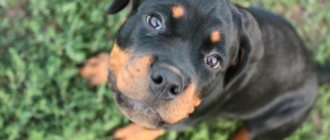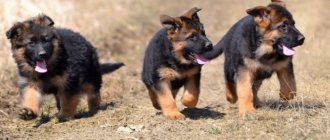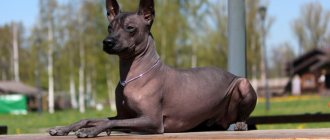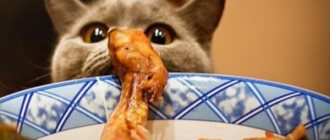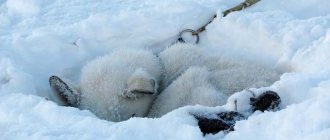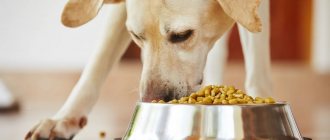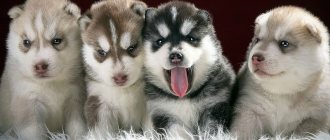In order for husky puppies to grow into beautiful and stately dogs, it is important to feed them properly. Nutrition and feeding of a husky puppy will be discussed in the article.
Husky dogs have become very popular these days. And if earlier their habitat was limited to the northern latitudes, where huskies were not only loyal friends to humans, but also a driving force, now they are kept in urban environments as pets.
There is no doubt that huskies are very impressive animals, but at the same time they are far from decorative lap dogs. In order for puppies of this breed to develop correctly, they need to choose a competent diet and lifestyle, and not be lazy about taking long walks with fairly heavy loads. Therefore, before you buy a fashionable puppy, carefully study our material about what kind of nutrition you will need to provide him.
Why do huskies need special food?
Raising an energetic and healthy Husky requires a nutritious, high-calorie diet. They do not need a low-calorie diet because they are not prone to overeating or obesity. Huskies easily digest protein-rich fatty meat and fish.
They, like northern animals, are characterized by protein-fat metabolism, and not the protein-carbohydrate metabolism typical of other dogs. Therefore, when compiling a diet, the peculiarities of metabolic processes must be taken into account.
Feeding and growth of puppies
Healthy puppies gain weight quickly. By two weeks of age, they triple the weight they had at birth, at two months they weigh 4-6 kg, and by one year their weight reaches 26-28 kg. A small husky will not be able to develop normally without sufficient physical activity. Just jogging down the street while walking is not enough. The puppy needs at least half an hour a day to play outdoor games. And it doesn’t matter what the air temperature is: the baby will adapt perfectly to temperature conditions from -20 to +25 degrees.
Such intense loads require replenishment of spent energy. You need to feed your husky puppy often, in small portions. Products for your baby should not cause digestive problems and contain sufficient amounts of vitamins and beneficial microelements. Then all the nutrients received from food will be fully absorbed, and the dog will grow up healthy and strong.
Husky recipes
Meat porridge (2 servings)
For 500 - 600 grams of beef trim, pour 13 cups of porridge (buckwheat or rice) with water. After boiling, add grated carrots, finely chopped cabbage or zucchini, and bay leaf. Add a little salt. No seasonings can be added.
Chicken porridge (4 servings)
Pour 1 kg of chicken legs with water and cook until half cooked, add half a glass of rice, grated carrots, finely chopped onion, bay leaf. Cook until the rice is ready.
Oatmeal
There is no need to cook the flakes, pour in hot broth (meat or vegetable), cover with a lid and let sit for 30 minutes. Add half a teaspoon of butter or sunflower oil.
Calcined curd
For 1 liter of boiling milk, add 3 - 4 tablespoons of a 10% calcium chloride solution (sold at the pharmacy). Place on a sieve and strain. Cottage cheese is served warm to the puppy; it is an excellent remedy for the prevention of rickets.
There are no special requirements for bowls; they must always be clean, just like for food and water. Change your dog's water every day. True, puppies love to play, so fragile ceramic, plastic, porcelain or glass will not work. Metal utensils work well. The four-legged friend will not chew it or break it.
Huskies just need to be loved. In caring hands, obedient, affectionate and cheerful dogs grow up.
In the first month
From the moment they are born, puppies feed on their mother's milk. With milk, they receive all the nutrients and vitamins necessary for growth and development, so there is no need to introduce additional complementary foods. If for some reason the pet switches to artificial feeding, then hypoallergenic milk substitutes, for example, Royal Canin Babydog Milk, are used for its nutrition. The dry mixture is easily diluted with water.
Cow's or goat's milk is not suitable for puppies, because... Dog food contains much more proteins, fats, and minerals. A newborn puppy is fed from a bottle with a nipple.
Complementary feeding with natural food or dry food begins to be introduced to babies at 3-4 weeks of life. At this time, the need for energy sources increases. The body is actively growing, developing, and needs vitamins and microelements. Home-fed puppies begin to be fed gradually. Children are given milk porridge, cottage cheese, meat broth, grated boiled carrots. By the age of one month, the puppy still receives alternately mother’s milk and complementary foods.
General tips for proper feeding
Obesity or exhaustion is not typical for huskies; if this is observed, it is recommended to change the diet and add physical activity. It is advisable to divide the diet into a winter diet, in which the dog receives 30% more food, and a summer diet, which is calm.
The appearance and condition of the dog is the main indicator of nutritional balance.
A dog that receives sufficient regular exercise looks lean, has three visible outer ribs and pronounced muscles. The young dog is moderately well-fed, a little fat can be felt on the ribs - this is a necessary condition for further growth and proper development of the skeleton and muscles.
At 3-4 months
At 3 months, puppies eat raw meat, which they need for active growth and an active lifestyle. By this age, the dog already weighs 9-10 kg, and its teeth grow. Closer to 4 months, the meat is partially replaced with fish, previously cleaned, without the head, passed through a meat grinder. The fish they give is from the sea; start with boiled, gradually moving to raw.
At this age, pets are transferred to a feeding schedule 4 times a day. When feeding a husky puppy, it is important to follow the rule: walk first, then eat.
How to soak food
One of the basic rules for soaking dry food is not to stock it up. Dry food diluted with water quickly deteriorates and loses its beneficial properties, which can cause disruption of the digestive system. You need to prepare food in the amount that the puppy will eat at one time.
The algorithm for soaking food is incredibly simple and consists of only two points:
- Pour the required volume of granules with purified or boiled water at a temperature of about 40 degrees.
- Leave for 20-40 minutes to soften, then offer to the puppy.
The degree of soaking directly depends on the time spent in water. The longer you wait, the more the food will resemble porridge.
Note! If the puppy has not eaten all the soaked food, the leftovers should be placed in the refrigerator and stored there for no more than 12 hours.
Many novice dog breeders do not realize the consequences of not feeding a puppy correctly. In the first months of life, the fundamental foundation of a pet's health is laid, and an incorrect diet will do everything possible to undermine the puppy's condition. If you have difficulty creating a menu on your own, it is better to seek help from a veterinarian.
What you can and cannot feed your husky
The diet of a husky puppy contains a large amount of protein and consists of the following components:
- 60-70% of the diet consists of sea fish and meat - beef, rabbit, turkey. Huskies are sometimes allergic to chicken meat, so it is introduced into the puppy’s menu carefully, in small portions. Useful by-products: liver, heart, lungs, tripe. For small huskies, bones are more of a toy than a complete meal. They can be given to puppies up to 4-5 months of age;
- up to 10% of the total food consists of porridge made from buckwheat, rice, millet, oats with the addition of egg yolk once or twice a week;
- 10-20% of the puppy’s diet consists of fermented milk products: yogurt, cottage cheese, kefir, fermented baked milk;
- 10% is allocated to vegetables: carrots, beets, cabbage, zucchini, pumpkin, cucumbers, tomatoes.
As a treat, huskies are fed fruits - apples, pears, bananas, and berries.
Husky owners should forget about some pet products forever:
- raw lamb and pork;
- River fish;
- table waste;
- fried, smoked, fatty, sweet dishes;
- raisins and grapes;
- boiled and tubular bones;
- potato;
- legumes and cabbage.
How to properly feed a husky puppy at 2 months. Regime and education
A growing dog should get used to a daily routine, so feeding and walking times should never be disrupted. His health depends on the stability of the regime. A two-month-old dog needs to be fed 5-6 times a day. As you grow older, the number of techniques is reduced to three, and then to two times. A strict rule - no snacks before a walk, only after. A meat dish must be served for dinner.
The amount of food should be optimal, eliminating overeating and undereating. If the stomach stretches and the intestines are overloaded, this can lead to diarrhea, pancreatitis, gastritis, weight gain and other disorders. A bloated belly after feeding indicates that portions should be smaller, but more frequent. The contents of the bowl are eaten before licking, but if the animal is restless, whines, or licks the bottom for a long time, it is not enough. When a pet does not want to eat at the set hour, this is a sign of possible malaise. If the incident repeats, you should immediately contact a veterinarian.
Eating behavior and education
A strictly single place should be allocated for feeding from a permanent bowl of approximately two-liter volume. It is preferable to choose a metal or plastic container. It’s better to go with a metal one - it’s durable and not afraid of teeth. The base of the bowl must be stable. Sometimes you should feed while holding the bowl yourself: the animal must allow the person to approach the food. It is important not to teach him to eat from his hands. Without wasting time, all residents of the house must ensure that any delicacy is back in the hands of a person at the first command. This is a vital skill that will help you pull a dangerous object or low-quality product out of your mouth in time. Sequencing:
- The command “Fu” or “Give” is voiced;
- A piece is taken away;
- In return, a new one is issued, tastier and larger.
The conditioned reflex will take hold very soon, but you should not forget about its periodic training, otherwise everything will be forgotten. The four-legged animal should be fed only before or after the whole family has eaten. This is important, otherwise you will develop the habit of begging. It is forbidden to feed your own food; this is unacceptable during the training process and negatively affects the digestion of dogs of this breed. The normal feeding time is 10-15 minutes, after which the bowl is rinsed with boiling water and dried.
Dry food and canned food
Ready-made food is balanced with all nutritional components necessary for normal growth and development of pets. In addition, they are very convenient to use. If the owners choose to eat industrial food, then they buy special food for puppies from the “Starter” line. It contains more vitamins, macro- and microelements. Puppy food is not suitable for an adult dog, as it no longer requires such a large amount of vitamins. In high doses they cause disturbances in the functioning of the body.
Specialized food for husky puppies contains high fat and low carbohydrates.
Feeding with dry food begins once a day. The serving size is several granules. Over the course of a week, the amount of granules is gradually increased. Up to 6-8 months, dry food granules are soaked in warm water, kefir, milk or meat broth.
After six months, the pet is transferred to ready-made food with a reduced protein content, no more than 25% of the composition. These feeds belong to the “Junior” class.
When feeding dry food, puppies should always have fresh water freely available.
When choosing food, take into account the following parameters:
- meat should come first in the ingredients;
- for huskies, beef, chicken, lamb are suitable;
- fish feed alternates with meat;
- the feed must contain vitamin E, which is used as a preservative in high-quality feed;
- food should not contain soy, corn, artificial colors, preservatives, or flavors.
Only premium and super premium food meets these requirements, including Eukanuba, Hill's, Orijen, Acana, Royal Canine, Happy Dog and others. Cheap products contain a lot of starch. The husky's gastrointestinal tract does not tolerate it well.
Canned food is usually mixed in small portions with dry food to diversify the diet.
Nuances of feeding in the summer
In the morning the pet is offered less calorie food, in the evening it receives the main food. The menu for the week is calculated in advance in such a way as to relieve the digestive system a little in the middle of the week, and by the end of the week energy-intensive and protein-rich foods are added to the diet. Before long walks, training, or exhibitions, the dog is fed light food; in the evening on the day of the event, a high-protein food is given.
In summer, the portion is reduced compared to winter, since heat loss is reduced. It is recommended to give preference to easily digestible foods with sufficient vitamins. Optimal menu:
- 40% – raw beef;
- 10% – boiled offal;
- 20% – rice porridge;
- 20% – dairy products;
- 10% – boiled vegetables.
The animal is given vitamin complexes for joints and bones all year round. It is prohibited to combine natural and dry food in a husky’s diet. This can affect the functioning of the gastrointestinal tract and lead to illness.
The daily food allowance is written on the back of the package; owners only need to adhere to the amount specified by the manufacturer. To calculate the morning and daily portions, the norm is divided by two. What does your pet prefer? Share your opinion in the comments!
Vitamins and mineral supplements
In addition to frequent and fractional nutritious meals, the young husky is provided with vitamins and minerals. From the age of four months, specially selected complexes begin to be added to the diet:
- vitamins A and C increase immunity, help the body resist the effects of pathogenic bacteria and viruses;
- vitamin B keeps the coat, skin, and muscles healthy;
- vitamin D strengthens bones and joints, prevents rickets;
- vitamin E is involved in the formation of reproductive function;
- calcium, iron, zinc, iodine, phosphorus are necessary for the formation of the skeleton, nervous system, the formation of proper metabolism, for thick and smooth coat.
Vitamin and mineral complexes are chosen for your pet on the advice of a veterinarian, taking into account the developmental characteristics and health status.
The ancestors of dogs lived in conditions of calcium deficiency. A puppy who eats natural food is given mineral supplements (calcium glycerophosphate) twice a day:
- up to 2 months – 1-1.5 g;
- 2-4 months – 1.5-2 g;
- 4-6 months – 2 – 3 g;
- from 6-12 months – 2.5 g.
Diet from six months to a year
As puppies grow older, their diet must be changed. It is necessary to gradually increase the amount of meat, reducing the amount of dairy products. At the age of six months, a dog should eat about 70% of the total food per day.
Important! From 4-6 months, depending on the breed, the animal can be given offal. We are talking about the liver, spleen, heart and lungs.
From six months of age, you can also start giving your pet fish in small quantities. Preference should be given to marine representatives. Dairy products no more than 20-30% per day, the amount of vegetables and fruits remains the same, and cereals are gradually introduced.
If the animal is fed with ready-made industrial formulations, then it is necessary to choose certain types, the packaging of which contains notes about the appropriate age.
Scheme of complementary feeding with natural food
Reviews
Olga, Magnitogorsk
“When little Hector appeared in the house, my head was spinning - what to feed, what was possible, what was not! I've read so much. I tried different options and products for up to 6 months. Then I spat and feed her in my own way: in the morning - meat, chicken, beef, offal, in the evening - dry food. Sometimes I give cottage cheese, kefir, eggs. Definitely vitamins. He doesn't eat porridge. The dog is already two years old, no problems - his fur is shiny, he runs after his bicycle, catches mice and ducks. He eats them too."
Valentina, Kirov
“I will be happy to share recipes from the menu of my six-month-old husky. Usually in the morning I give him porridge with meat. Pour 300 g of meat and a third of a glass of cereal with water and put on fire. After the porridge boils, add carrots and zucchini or bell peppers to it. If you have ready-made meat broth from which I cook cabbage soup for the family, then pour hot oatmeal over the oatmeal and leave for 30 minutes. You can add a little vegetable oil.”
Natural food for huskies
When choosing a diet made from natural products for your pet, take into account the fact that it will take more time to prepare, but you know exactly what your pet is eating. Watch your puppy's behavior and he will tell you what vitamins he needs. If he refuses cottage cheese, this means calcium is normal; you can avoid giving it to him for 3-4 days. He eats fish with gusto and feels the need for phosphorus. Loves cucumber too much, needs mineral supplements.
Healthy foods for your husky puppy
- low-fat cottage cheese
- seasonal fruits
- porridge (rice, buckwheat, sometimes oatmeal, pearl barley, corn). You can cook it in meat broth, fish broth, with vegetables, or simply in water in a ratio of 3 parts meat to 2 parts porridge. Huskies should be fed meat and porridge, and not the other way around.
- kefir, fermented baked milk
- sea fish with soft bones (salmon, pink salmon), they like it raw with scales and fins. Remember that this is a delicacy or delicacy, but not the main food.
- venison, beef, or beef trimmings, with all cartilage, fat and films (pour boiling water)
- beef lungs, spleen, heart, liver (be sure to boil to avoid infection with worms)
- boiled chicken
- pork, lamb - not allowed, they destroy the dog's liver.
Meat is digested slowly, unlike other foods. Therefore, at night or between long walks, feed your dog meat dishes.
Sample menu for a husky puppy from 2 months
- 9 -00 (low-fat cottage cheese, grated raw carrots, apple or 2 quail eggs)
- 13 – 00 (150-200 grams of raw or scalded meat or fish)
- 17 – 00 (400-500 ml kefir)
- 20 -00 (porridge with meat, proportion 2/1)
By 4 - 5 months - we deprive the afternoon snack
At 7-8 months - we remove lunch
Husky nutrition at 1 year
- breakfast 9-00 (cottage cheese, meat or fish)
- dinner 20-00 (porridge with meat)
Determine the number of servings based on your dog's appetite. If it’s not enough, he will eat it as a sneak and rattle the bowl, but won’t finish the larger portion. Huskies have a big sweet tooth, a piece of banana, a spoonful of honey or dried apricots are only beneficial for them.
Sugar and chocolate should not be given to dogs.


